#newari thangka
Explore tagged Tumblr posts
Photo
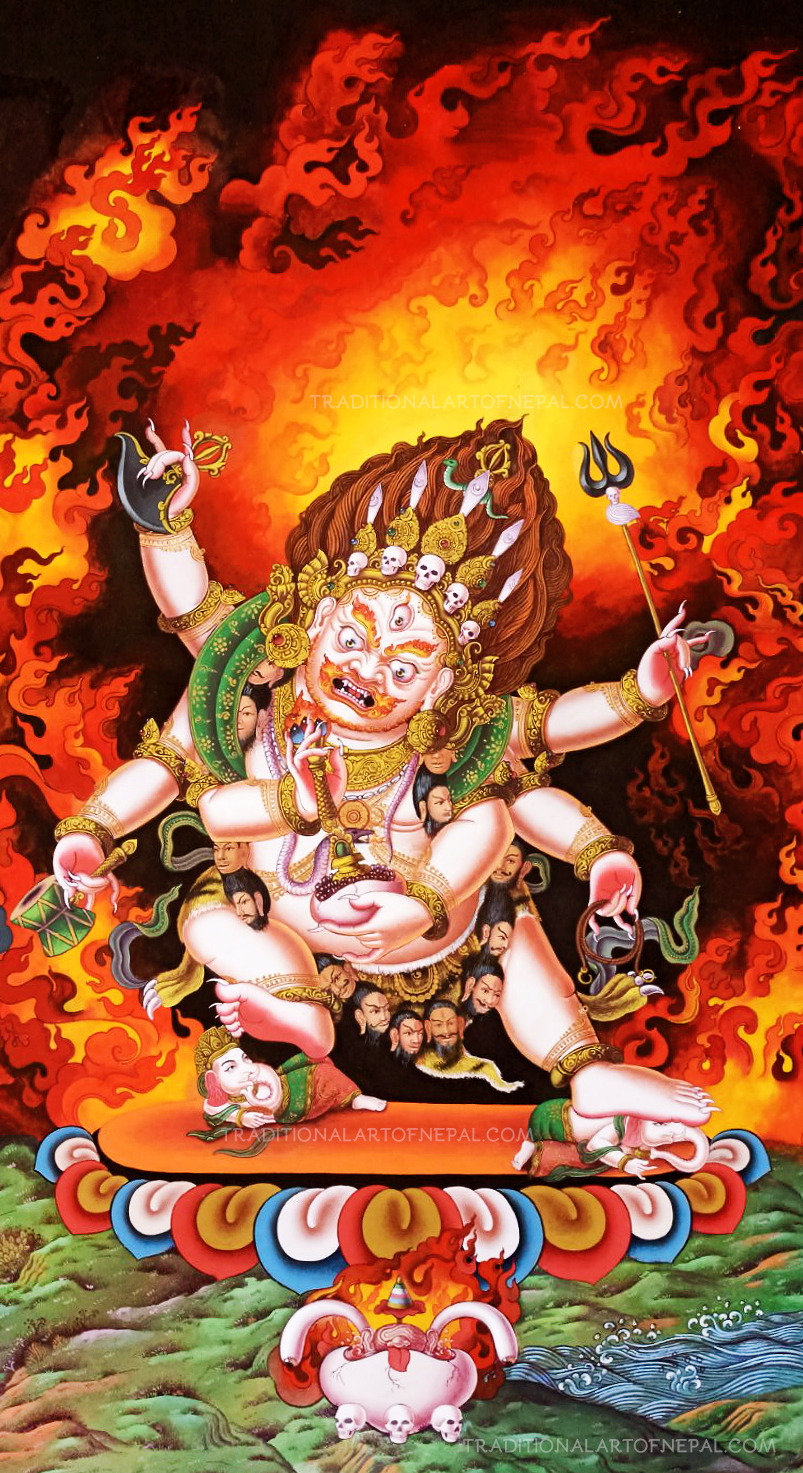
There's no advantage in deceiving yourself. Good and bad are distinct. Cause and effect are clear. But fools don't believe and fall straight into a hell of endless darkness without even knowing it. ~ Bodhidharma
56 notes
·
View notes
Text
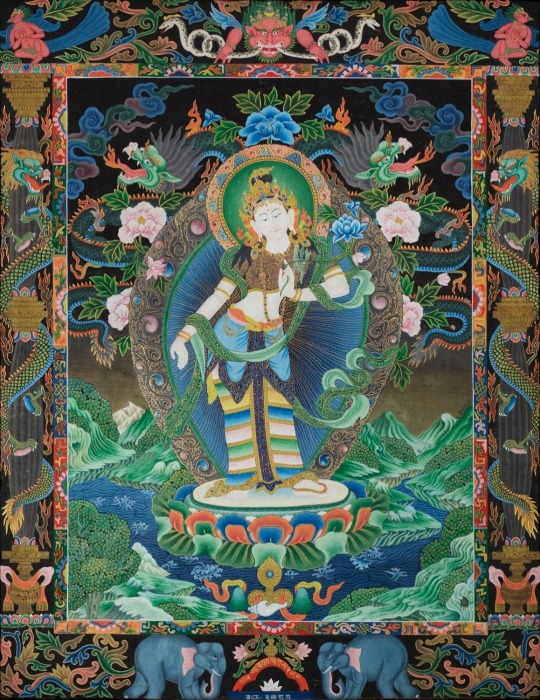
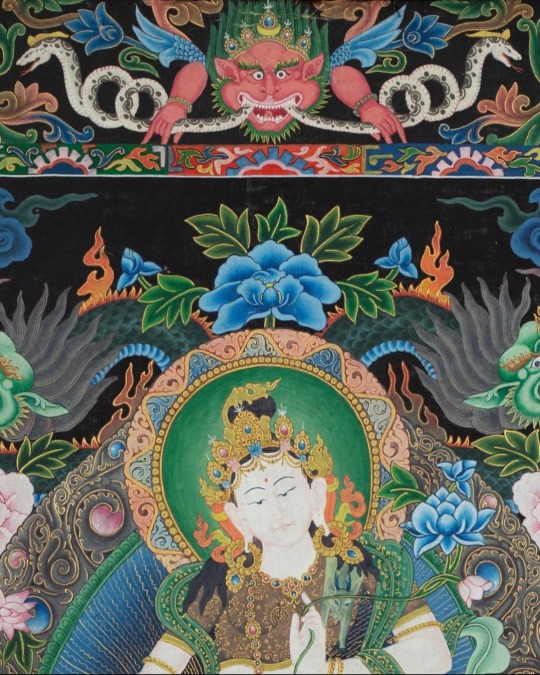
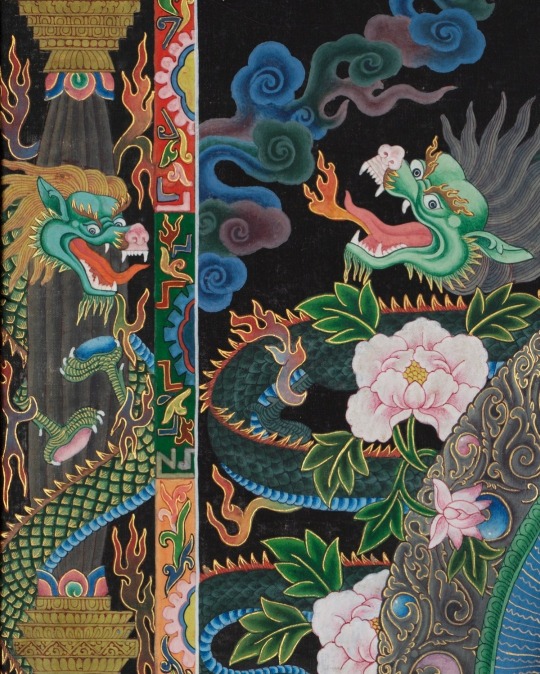
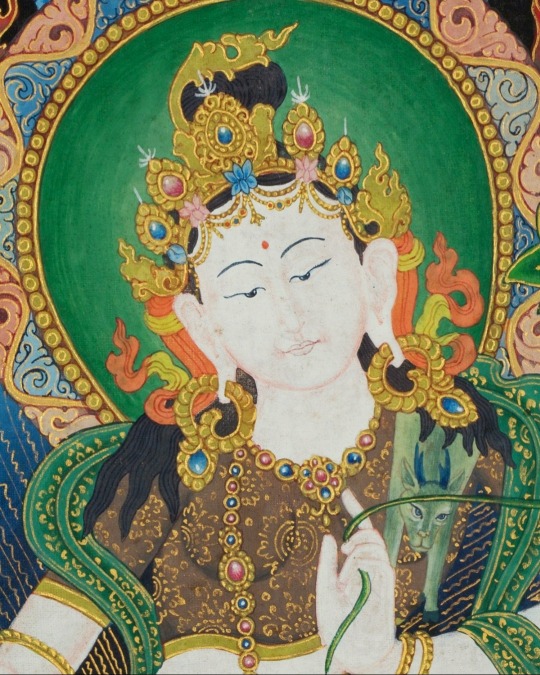

Newari Style Bodhisattva Padmapani Lokeshvara in 24 carat gold, gouache and acrylic colors on cotton canvas.
#no artist identification#buddhist art#newari#nepalese#thangka#buddhism#padmapani lokeshvara#bodhisattva
40 notes
·
View notes
Text

Vajrayogini
Newari Paubha Thangka
The Vajrayogini Mantra: Benefits, Practice, Empowerment
The Vajrayogini is a tantric deity in Buddhism who represents the path that leads to female Buddhahood. She is regarded as the goddess of grace as well as destruction as she destroys the illusions of the ego.Vajrayogini is a 16-year-old female dakini embodying divine wisdom. She is a feisty manifestation of the divine feminine.
There are several representations of Vajrayogini, but she is mostly depicted as a young and naked tantric deity, blood red (representing her inner fire), wearing ornaments of the human skeleton, a necklace of skulls(representing 16 vowels and 32 consonants that symbolizes purity of speech).
She stands fiercely, holding a flaying knife in her right hand, using it to cut off all attachments. In her left hand, she holds a skull cup filled with mahasukha(eternal bliss); she pours these out to her devotees with compassion. She is surrounded by beaming flames of awareness. She looks up towards the pristine realm of Khechara and drinks from the skullcap on her left hand.
Practices related to Vajrayogini and the Vajrayogini mantra are often kept a secret, as anyone with limited knowledge can easily misinterpret it. The Vajrayogini practice is a sacred practice which requires guidance . If these practices are misinterpreted then the practitioners will have to face the severities including ; health issues, mental disturbance and spiritual regressions as well.
Vajrayogini Short Mantra oṃ va jra yo gi nī hūṃ pha ṭ svā hā oṃ vajrayoginī hūṃ phaṭ svāhā
This Vajrayogini mantra holds immense significance in Tibetan Buddhism. It comes from Anuttara Yoga tantra and should be recited with proper guidance and instructions. Like any other Tibetan Buddhist mantra; this Vajrayogini mantra can be a powerful tool for self-transformation, healing and liberation from samsara. This mantra is especially beneficial for women as they can relate more to the female deities.
Understanding the Vajrayogini Mantra Meaning
om om om sarva buddha dakiniyé benza warnaniye benza bairotsaniyé hung hung hung phat phat phat soha
oṃ va jra yo gi nī hūṃ pha ṭ svā hā
oṃ vajrayoginī hūṃ phaṭ svāhā
According to the Vajrayarahi tantra, after understanding this mantra, if one recites it 36 times every day, they can benefit from this not only in this lifetime but at the bardo state and lifetimes after that as well.
Each syllable and word in this mantra holds meaning and significance. Let's dissect them to get a better understanding.
OM- Om is a sacred syllable regarded as the universal sound. Om is indicative of the nature of the consciousness or the ultimate reality.
Vajrayogini: Vajrayogini is a fierce goddess embodying divine wisdom.
Hum-Hum is a seed syllable that is associated with Vajrayogini. This syllable is indicative of essence and her power. This is used to invoke her presence and blessings.
Phat-Phat is a dynamic syllable used as a shield against negative forces and dispels obstacles along the way.
Svaha: This is a commonly used syllable in Buddhism and Hinduism. This is used to seal the mantra and make an offering towards the deity while expressing one’s dedication and surrender.
All the mantras and practices related to Vajrayogini are often regarded as a secret and should not be chanted without instruction. Vajrayogini mantras are widespread all over the internet today, but you should not risk chanting these without proper guidance from a Guru.
23 notes
·
View notes
Text

Jambhala, depicted in this Newari thangka, is a wealth deity who removes the obstacle of poverty and brings abundance to Dharma practitioners. He appeared before Shakyamuni Buddha to protect him from demons and became a Dharma Protector at Buddha's request. Jambhala's blessings bring good luck, virtues, intelligence, and material and spiritual benefits to those who call upon him or chant his mantra.
#dzambala#buddha#buddhist#buddhism#dharma#sangha#mahayana#zen#milarepa#tibetan buddhism#thich nhat hanh
8 notes
·
View notes
Text
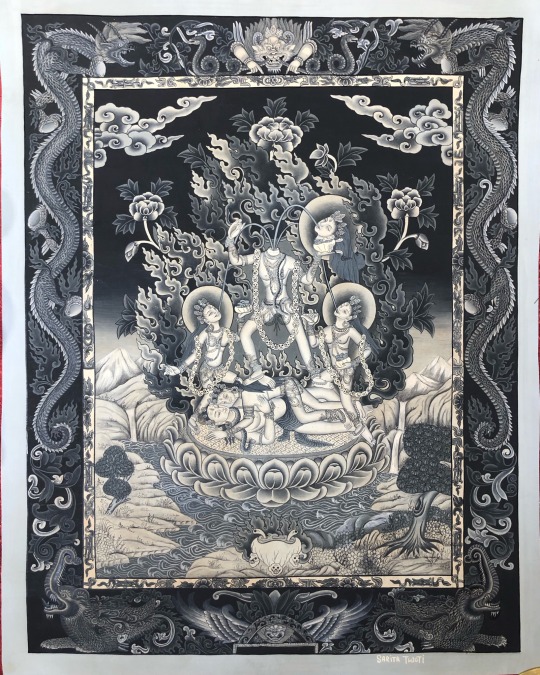
hinnamasta, also known as Chhinnamastika and Prachanda Chandika is one of the Tantric Goddesses in Hinduism. In Tantric Buddhism she is known as Chinnamunda. Chinnamasta Devi is a form of Shakti who is depicted as ferocious wrathful. Chinnamasta means, 'severed head'. The Hindu Divine Mother is commonly identified with her fearsome iconography. Chinnamasta symbolises both life-giver and life-taker. Chinnamasta is considered both as a symbol of self-control on sexual desire as well as an embodiment of sexual energy, depending upon interpretation.
Chinnamasta is closely related to Chinnamunda - the severed-headed form of the Tibetan Buddhist goddess, Vajrayogini.
Chinnamasta is mostly depicted nude and with dishevelled hair in blood red or black coloured body. In the texts, She is described to be a sixteen-year-old girl with full breasts and has a blue lotus near her heart. She is standing over a naked couple. The couple is said to be Rati, Goddess of sexual desire, and her husband Kama, God of love. Chhinnamasta is depicted wearing a serpent as a sacred thread and a garland of skulls or severed heads and bones like Maa Kali. Blood streams out of her neck and Her two female attendants Dakini and Varnini (also called Jaya and Vijaya) are drinking the blood.
In the left hand, She carries her own severed head (in a platter or a skull-bowl). In the right hand, She holds a khatri (a scimitar or knife) by which she decapitated herself.
.
.
.
.
.
#nepal #bhaktapurdurbarsquare #lamathankapaintingschool #thangka #thangkaschool #buddhism #hinduism #tantric #goddess #chinnamasta #vajrayogini #livingheritage #heritage #newari #design #sacred #thankapainting
5 notes
·
View notes
Text
Red Changreshi - Newari Thangka painted by Shakya Family
Red Chengreshi is a newari thangka painted by Shakya Family

View On WordPress
0 notes
Text
Exploring the Enchanting World of Famous Art and Craft of Nepal
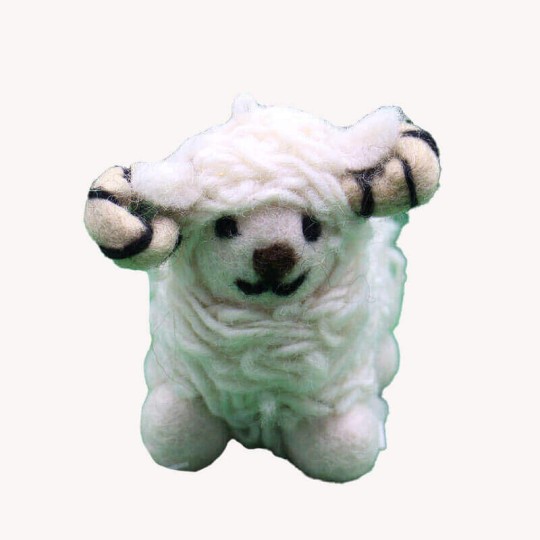
Nepal, nestled in the lap of the Himalayas, is a land of diverse cultures and artistic traditions that have flourished for centuries. Renowned for its breathtaking landscapes and rich cultural heritage, Nepal is equally celebrated for its famous art and craft, which reflect the country's deep-rooted spirituality and skilled craftsmanship. Let’s discuss about the enchanting art and craft of Nepal.
Thangka Paintings: Artistry in Divine Expression
Thangka paintings, intricate religious artworks, are a hallmark of Nepal's artistic legacy. These exquisite scroll paintings depict deities, mandalas, and cosmic symbols with meticulous attention to detail, often used for meditation and spiritual contemplation.
Wood Carvings: A Symphony of Art and Architecture
Nepali wood carvings adorn temples, palaces, and traditional buildings, showcasing the skillful craftsmanship and cultural symbolism. From intricately carved doors to ornate window frames, these wooden masterpieces are a testament to the fusion of art and architecture.
Metalwork: Glimpses of Elegance and Spirituality
Metalwork in Nepal encompasses an array of stunning creations, from graceful bronze statues of deities to finely crafted ritual objects like singing bowls and incense burners. Each piece carries a sense of spirituality and artistic finesse.
Pottery and Ceramics: Reviving Ancient Traditions
Nepali pottery and ceramics celebrate the country's ancient heritage. From utilitarian earthenware to exquisitely glazed ceramics, these creations reflect the harmonious relationship between art and daily life.
Handwoven Textiles: A Kaleidoscope of Colors and Patterns
Nepali handwoven textiles, such as Dhaka and Pashmina shawls, showcase the mastery of local weavers. The intricate patterns and vibrant colors narrate stories of cultural identity and craftsmanship.
Paper Crafts: Ancient Art in a Modern Context
Paper crafts like Lokta paper products and intricate paper masks connect Nepal's ancient traditions with contemporary creativity. These eco-friendly crafts blend heritage with innovation.
Thanka Artists: Guardians of Spiritual Heritage
Meet the skilled Thanka artists who dedicate their lives to preserving this ancient art form. Discover the meticulous process behind creating these sacred paintings and their significance in Nepali culture.
Newari Metal Crafts: A Glimpse into Kathmandu's Artistic Legacy
Explore the exquisite metal crafts produced by the Newar community in Kathmandu Valley. From brass statues to traditional utensils, Newari metalwork reflects the region's rich artistic heritage.
Handmade Jewelry: A Fusion of Elegance and Tradition
Discover the allure of Nepali handmade jewelry, featuring intricate designs inspired by Nepali culture and traditions.
Conclusion
The art and craft of Nepal provide a glimpse into the country's rich cultural fabric and artistic excellence. Spanning from ancient traditions to contemporary expressions, the masterpieces created by Nepali artisans are cherished not only within the Himalayan nation but also on a global scale. These artistic marvels embody timeless beauty & boundless creativity, captivating the hearts of art enthusiasts & cultural admirers worldwide.
#Nepal Handicraft Product#handicraft product in Nepal#Nepal Handicraft Wholesaler#Nepal Handicraft#Handicraft in Nepal#Nepal Handicrafts#Handicraft Shop in Nepal#Handicraft Export from Nepal#Handicraft Website#Nepal Handicrafts Wholesale#Online Nepal Craft#Art and Craft of Nepal#Nepali Handicrafts Online
1 note
·
View note
Text

Mahakala thangka - Newari, Nepal, c1990s
0 notes
Photo
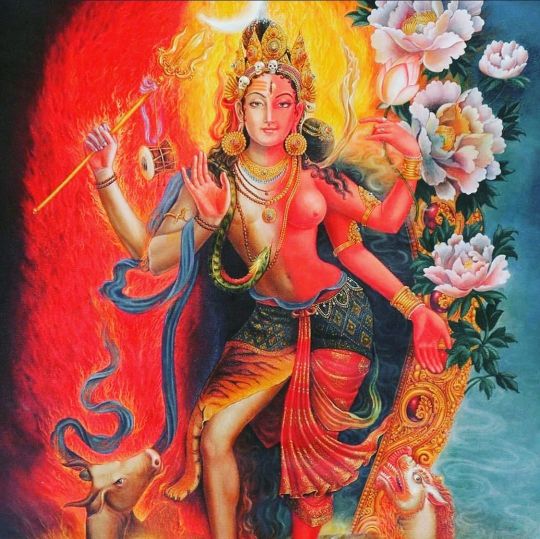
Ardhanarishvara ————————————————— “In Buddhism it doesn’t matter who you are- man, woman, straight, gay, lesbian, transsexual. It's not about those issues; its about how you work with your mind. If you have a mind, then whether it's straight or gay or lesbian or whatever doesn’t matter- mind’s nature is mind's nature. If the nature of mind is enlightened, then there you go." ———————————————————————— By Dzogchen Ponlop Rinpoche ————————————————— #luckythanka #paubha #vajrayana #vajra #yana #thangka #art #painting #vajrayanabuddhism #tibetanbuddhism #tibetanart #newariart #newari #vajradhara #bodhisattva #buddha #tantra #tantrayana #tantricsexuality #tantric #tantricbuddhism #shiva #shakti #gay #pride #dzogchen #shakta #gayrights #humanrights #om (at Lucky Thanka Art & Craft) https://www.instagram.com/p/B7NCmeahr6M/?igshid=1gwxij072ev6t
#luckythanka#paubha#vajrayana#vajra#yana#thangka#art#painting#vajrayanabuddhism#tibetanbuddhism#tibetanart#newariart#newari#vajradhara#bodhisattva#buddha#tantra#tantrayana#tantricsexuality#tantric#tantricbuddhism#shiva#shakti#gay#pride#dzogchen#shakta#gayrights#humanrights#om
2 notes
·
View notes
Photo

Red Tara is a female bodhisattva who steps down to earth yo be a service to mankind . Red tara is often worshiped by lovers who are unhappy. as it is believed to be extremely successful in enchanting people. Red tara can be invoked for the controlling activities of attracting , manifesting , magnetizing and subjugating.
3 notes
·
View notes
Photo

Compassion doesn’t just drop into the brain or into the heart like rain. The mind has to be trained in compassion.
~ Lama Zopa Rinpoche
59 notes
·
View notes
Photo

Yamantaka Vajrabhairava. Sakyapa Monastery, Central Tibet. 1400s.
#yamantaka vajrabhairava#thangka#yamantaka#tibetan buddhism#ground mineral pigment on cotton#15th century#newari artist#nepal#central tibet#sakyapa monastery#meditational art#lacmamuseum#magictransistor#alejandromerola#1400s
786 notes
·
View notes
Text
Special Newari Green Tara
Size:65x100cm
Limited piece
Just Arrived
DM for Inquiry
Worldwide Delivery
Website: www.newluckythanka.com
Instagram: newluckythankatreasures
Email: [email protected]
#newluckythankatreasures #thangka #thanka #greentara #tara #newari #newarithangka #compassion #special #gift #homedecor #officedecor #love #meditations #posperity #positivity
1 note
·
View note
Text

Manjushri is represented as a male Bodhisattva with this right hand wielding a flaming sword “ Vajra Sword of Discriminating Light ” that represents the sharpness of Prajna , and his left hand wielding beautiful blue lotus flower in full bloom. The Vajra Sword of Discriminating Light or Wisdom is believed to cut through ignorance and entanglements of conceptual views. This sword also represents light of transformation when the sword is in flames. The magnificent Lotus flower is believed to hold the Prajnaparamita Sutra (Great Wisdom Sutra ) and contains the essence of the great Wisdom of Lord Buddha .
.
.
.
.
.
#Heritage #livingheritage #nepaleseart #newari #pawa #painting #thangka #thankapainting #lamathankapaintingschool #sacred #wisdom #vajra #buddha #dhamma #enlightened #bhaktapurdurbarsquare
4 notes
·
View notes
Text
Swaying Lamps
These dreamy lamps will brighten your space in the smoothest way. This artwork is creatively designed in a modern outlook to attract the discrete creative minds. Mozaico thinks these beautifully white swaying lamps would romanticize any room they are brought to. They can appear as shiny jellyfish or exotic white flowers.
Eccentric Furniture
Influenced by the beauty of the human figure, the artist thought of merging this perfection into the art of interior design. This is an audacious and attractive semi-sculpture, semi-furniture design attracting everyone's attention: some want to criticize it while others admire it. However, at the end of the day no one could deny the creativity in these furniture designs. If you want an eccentric and daring interior décor, this sculptural furniture is ideal.
The Mandala Table
This mandala table is suitable for an outdoor gathering or even an indoor relaxing area. The vibrant colors of this artwork are manifested to make sure you will feel happy surrounded with positive vibes. The patterns of this hand painted decorative table look analogous to a mosaic artwork.
Early beginnings of Thangka art.
Thangka art began in ancient India where these sacred Buddhist Thangka paintings were referred to as 'Patrabhattrak' or simply 'Pata' meaning portrayal of divine figures on a flat surface. It was in the 5th century B.C when the art of Buddhist Thangka (also called Paubha in Newari and Pata in Sanskrit) emerged in India. According to Buddhist mythology, Buddhist Thangkas were the first portrayal of Gautam Buddha. It is attested by scholars of Buddhism that the enlightened one allowed a famous painter called Sharipura of North India to create his image. Sharipura was unable to see Lord Buddha with his naked eyes due to the powerful rays radiating from Buddha's body. Then, Gautam Buddha advised Sharipura to look at the shadows reflected on a sheet of cotton cloth. The painter then painted the first image of Buddha on that sheet according to Buddha's suggestion. In this way, the art of Buddhist Thangka was initiated.
1 note
·
View note
Photo

Red Vetali with Yamari, probably a newari paubha (thangka)
106 notes
·
View notes